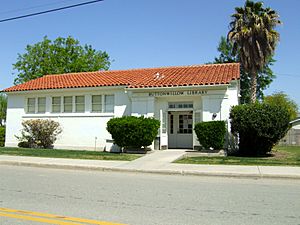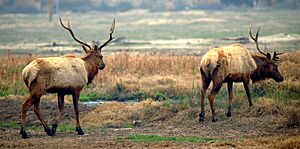Buttonwillow, California facts for kids
Quick facts for kids
Buttonwillow
|
|
|---|---|
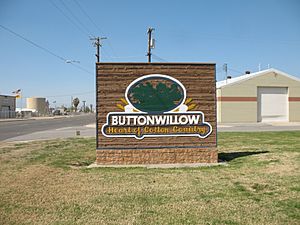
The entrance to Buttonwillow
|
|
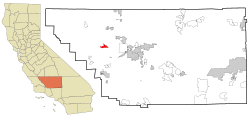
Location in Kern County and the state of California
|
|
| Country | |
| State | |
| County | Kern |
| Area | |
| • Total | 6.93 sq mi (17.94 km2) |
| • Land | 6.93 sq mi (17.94 km2) |
| • Water | 0.00 sq mi (0.00 km2) 0% |
| Elevation | 269 ft (82 m) |
| Population
(2020)
|
|
| • Total | 1,337 |
| • Density | 193.01/sq mi (74.52/km2) |
| Time zone | UTC-8 (PST) |
| • Summer (DST) | UTC-7 (PDT) |
| ZIP code |
93206
|
| Area code(s) | 661 |
| FIPS code | 06-09332 |
| GNIS feature ID | 1652678 |
Buttonwillow is a small community in the San Joaquin Valley in Kern County, California. It is located about 26 miles (42 km) west of Bakersfield. The community sits at an elevation of 269 feet (82 meters). In 2020, about 1,337 people lived there. Buttonwillow is also known as the "center of population" for California. This means it's the balancing point if you imagine all Californians standing on a map.
Contents
History of Buttonwillow
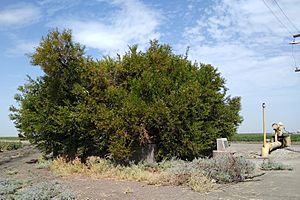
The town of Buttonwillow was first started in 1895. It was originally called Buena Vista. But soon after, its name changed to Buttonwillow.
Why is it called Buttonwillow?
The town gets its name from a special tree called the buttonbush (Cephalanthus occidentalis). A single buttonbush tree was a very important landmark. It was used by the ancient Yokuts Indian people as a meeting place. Later, settlers used it for their cattle roundups. A company called Miller & Lux even set up their main office and a store near this tree around 1885.
Today, this famous tree is recognized as California Historical Landmark No. 492. It is known as the Buttonwillow Tree. The landmark sign says: "This lone tree, which gave the town of Buttonwillow its name, served as a landmark on an old trans-valley trail. An ancient Yokuts Indian meeting place, it later became the site of settlers' stock rodeos. Miller and Lux established their headquarters and store here about 1885."
The first United States Post Office in Buttonwillow opened in 1895.
Things to Do and See in Buttonwillow
Buttonwillow is a popular stop for people driving on Interstate 5. You can find gas stations, restaurants, and travel centers here. These are all located near the exit for State Route 58.
Local Attractions and Industry
There is a large electrical substation near the town. This is an important part of the power lines that run north and south.
Buttonwillow is also a hub for car racing fans. Many members of the Sports Car Club of America stay in motels here. They come for events at the Buttonwillow Raceway Park.
The town also hosts the "Best in the West jet rally." This is an exciting yearly event where people gather to fly model jet planes.
The main business in Buttonwillow is cotton farming. The area is famous for its large cotton fields.
Geography and Environment
Buttonwillow covers an area of about 6.9 square miles (17.9 square kilometers). All of this area is land. As mentioned, it's known as "cotton country" because so much cotton is grown nearby.
Elk Hills Oil Field
About 4 miles (6.4 km) south of town is the huge Elk Hills Oil Field. This is a very large area where oil is found. Today, Occidental Petroleum is the main company that operates this oil field.
Climate in Buttonwillow
Buttonwillow has a cold desert climate. This means it has very hot and dry summers. The winters are cool.
| Climate data for Buttonwillow, California (1991–2020 normals, extremes 1940–present) | |||||||||||||
|---|---|---|---|---|---|---|---|---|---|---|---|---|---|
| Month | Jan | Feb | Mar | Apr | May | Jun | Jul | Aug | Sep | Oct | Nov | Dec | Year |
| Record high °F (°C) | 80 (27) |
85 (29) |
92 (33) |
100 (38) |
110 (43) |
114 (46) |
114 (46) |
114 (46) |
113 (45) |
102 (39) |
94 (34) |
81 (27) |
114 (46) |
| Mean maximum °F (°C) | 69.9 (21.1) |
76.0 (24.4) |
83.1 (28.4) |
91.6 (33.1) |
98.8 (37.1) |
104.3 (40.2) |
105.7 (40.9) |
105.3 (40.7) |
102.3 (39.1) |
94.0 (34.4) |
80.9 (27.2) |
70.5 (21.4) |
107.8 (42.1) |
| Mean daily maximum °F (°C) | 57.6 (14.2) |
64.0 (17.8) |
69.8 (21.0) |
76.0 (24.4) |
84.3 (29.1) |
92.4 (33.6) |
97.8 (36.6) |
96.6 (35.9) |
91.4 (33.0) |
80.8 (27.1) |
67.3 (19.6) |
58.2 (14.6) |
78.0 (25.6) |
| Daily mean °F (°C) | 47.5 (8.6) |
52.4 (11.3) |
57.5 (14.2) |
62.5 (16.9) |
70.2 (21.2) |
77.3 (25.2) |
82.7 (28.2) |
81.2 (27.3) |
75.8 (24.3) |
65.6 (18.7) |
54.1 (12.3) |
46.9 (8.3) |
64.5 (18.1) |
| Mean daily minimum °F (°C) | 37.5 (3.1) |
40.9 (4.9) |
45.3 (7.4) |
49.0 (9.4) |
56.1 (13.4) |
62.3 (16.8) |
67.7 (19.8) |
65.8 (18.8) |
60.1 (15.6) |
50.5 (10.3) |
40.8 (4.9) |
35.6 (2.0) |
51.0 (10.6) |
| Mean minimum °F (°C) | 27.9 (−2.3) |
31.0 (−0.6) |
35.4 (1.9) |
38.8 (3.8) |
46.4 (8.0) |
52.2 (11.2) |
59.2 (15.1) |
57.4 (14.1) |
50.7 (10.4) |
39.8 (4.3) |
30.1 (−1.1) |
25.9 (−3.4) |
24.5 (−4.2) |
| Record low °F (°C) | 9 (−13) |
19 (−7) |
26 (−3) |
30 (−1) |
38 (3) |
40 (4) |
38 (3) |
42 (6) |
37 (3) |
25 (−4) |
21 (−6) |
12 (−11) |
9 (−13) |
| Average precipitation inches (mm) | 1.19 (30) |
1.06 (27) |
1.15 (29) |
0.47 (12) |
0.27 (6.9) |
0.04 (1.0) |
0.07 (1.8) |
0.00 (0.00) |
0.03 (0.76) |
0.26 (6.6) |
0.46 (12) |
1.01 (26) |
6.01 (153) |
| Average precipitation days | 6.3 | 6.0 | 5.4 | 2.8 | 1.6 | 0.2 | 0.2 | 0.1 | 0.3 | 1.5 | 2.7 | 5.0 | 32.1 |
| Source: NOAA | |||||||||||||
People of Buttonwillow
| Historical population | |||
|---|---|---|---|
| Census | Pop. | %± | |
| 2000 | 1,266 | — | |
| 2010 | 1,508 | 19.1% | |
| 2020 | 1,337 | −11.3% | |
| U.S. Decennial Census 1850–1870 1880-1890 1900 1910 1920 1930 1940 1950 1960 1970 1980 1990 2000 2010 |
|||
The population of Buttonwillow has changed over the years. In 2000, there were 1,266 people. By 2010, the population grew to 1,508. In 2020, it was 1,337 people.
Population in 2010
In 2010, Buttonwillow had 1,508 residents. Most people lived in family homes. About 35.4% of the population was White. About 2.4% was African American. About 0.7% was Native American and 0.7% was Asian. A large part of the population, 59.0%, was from other races. People of Hispanic or Latino background made up 78.4% of the population.
There were 379 households in Buttonwillow. Many of these households (59.4%) had children under 18 living there. The average household had almost 4 people. The average family had about 4.3 people.
The ages of people in Buttonwillow varied. About 37.2% of the people were under 18 years old. About 6.1% were 65 years or older. The average age was 26.5 years.
Population in 2000
In 2000, Buttonwillow had 1,266 people. There were 328 households. About 56.4% of households had children under 18. About 61.6% were married couples. The average household size was 3.81 people.
The racial makeup was about 34.28% White and 3.79% Black. About 1.66% were Native American. People from other races made up 55.06%. About 68.40% of the population was Hispanic or Latino.
The median age was 24 years. This means half the people were younger than 24 and half were older.
Community and the Environment
Buttonwillow is home to one of California's two active hazardous waste landfills. This facility is called the Lokern Facility. It is located about 8 miles (13 km) west of the community. The facility was built in the 1970s. Many local residents were not told about it at first.
Concerns about Transportation
Highway 58 is a busy road that goes through the community. Trucks from the facility use this road to transport materials. Sometimes, as many as 200 trucks a day travel near the community. These trucks follow a special route to avoid going directly through the town.
Some studies have looked at how often spills happen when toxic waste is transported. These studies suggest that spills are more likely to happen near where the waste starts its journey. Because many trucks travel in and out of Buttonwillow every day, residents of nearby communities might be at higher risk. Spills can happen due to human error or vehicle problems.
Community Action and Awareness
It took almost ten years for Buttonwillow residents to learn about the facility. Even then, they felt it was hard to make a change. In 1988, the company that owned the facility wanted to build an incinerator. This would burn a large amount of toxic waste each year. However, this project was never approved.
In 1992, some residents became concerned about health issues in the community. They started to wonder if the facility's activities were connected. However, no official health study has ever been done to confirm a link between the facility and residents' health.
Proposed Expansion and Community Involvement
Also in 1992, the company wanted to make the facility much bigger. They wanted to double its size. They also wanted to handle many more types of chemicals, including some that were very hazardous.
A group called the Local Assessment Committee (LAC) was formed to discuss these plans. This committee was created because of a California law called the Tanner Act. This law was meant to give local residents a say in environmental decisions in their area.
However, many Buttonwillow residents felt that the LAC meetings were not fair. Even though meetings were held in Buttonwillow, no residents from the community were on the committee. Also, there were no members of Latino background, even though most Buttonwillow residents were Latino. Many residents spoke mostly Spanish, but there was no one to translate for them at the meetings for a long time. This made it hard for them to participate. In June 1992, a Spanish translator was finally provided. One month later, the committee was stopped.
In September 1994, the committee was started again. During this time, a report was made about the possible environmental effects of the expansion. This report is required by California law.
The committee faced challenges in working with the county. They wanted to set their own meeting plans and hire their own experts. But the county did not want to give them this power. After a short time, the county decided to approve the facility's plans and stopped the committee again. Some believed the decision was already made before the meetings.
The community group Padres Hacia una Vida Mejor worked to help residents. They focused on getting rights, like Spanish translation for important documents and meetings. Sometimes, the issue of language created divisions among residents. Some English-speaking residents did not support the translation efforts. Despite these challenges, the people of Buttonwillow continue to work for their community.
Images for kids
See also
 In Spanish: Buttonwillow para niños
In Spanish: Buttonwillow para niños



